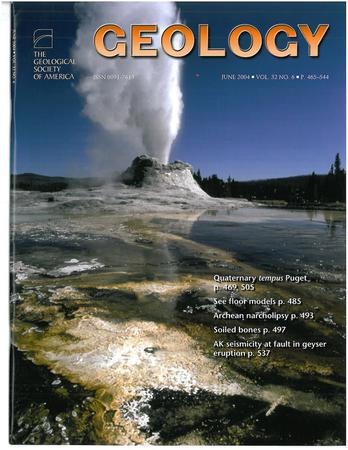海底扩张以及硫和金属向地球海洋的输送
IF 4.8
1区 地球科学
Q1 GEOLOGY
引用次数: 0
摘要
地球洋中脊系统内的循环流体冷却并改变了海洋地壳,为海洋贡献了独特的化学物质,并在海底产生了具有重要经济和地质意义的金属硫化物矿床。然而,对于这些流体在海底压力和温度峰值条件下的特征,以及海底扩张这一主要变量如何影响这些流体向海水输送金属和硫,我们几乎没有什么限制。在这里,我们开发了一种新的、强大的技术来估计海底热液中热量和溶解的硫、铁和铜的峰值禀赋,并确定这些过热流体上升到海底时它们的命运。使用该技术的计算表明,由于冷却和硫化物矿物溶解度的降低,在上涌过程中,在海底峰值条件下溶解的20% - 70%的硫、铁和铜会丢失。在通风孔场的地质背景下对这些估计的解释使我们能够证明海底扩张速度与峰值压力-温度条件、海底热损失和海底硫化物矿化程度之间存在强烈的反比关系。我们的研究结果表明,地球洋中脊系统在地质时期的长期变化在多大程度上影响了硫化物沉积速率以及硫和金属进入海洋的热液通量。本文章由计算机程序翻译,如有差异,请以英文原文为准。
Seafloor spreading and the delivery of sulfur and metals to Earth’s oceans
Circulating fluids within Earth’s mid-ocean ridge system cool and alter the oceanic crust, contribute distinct chemistry to the ocean, and generate economically and geologically important metal-sulfide deposits at the seafloor. Yet, we have few constraints on the characteristics of these fluids at peak subseafloor pressure and temperature conditions or how the primary variable, seafloor spreading, affects these fluids’ delivery of metals and sulfur to seawater. Here, we develop a new, robust technique for estimating the peak endowment of heat and dissolved sulfur, iron, and copper in subseafloor hydrothermal fluids and determining their fate as these superheated fluids rise to the seafloor. Calculations using this technique indicate that >20%−70% of sulfur, iron, and copper dissolved at peak subseafloor conditions are lost during upflow due to cooling and concomitant decreases in sulfide mineral solubility. The interpretation of these estimates within the geologic context of vent fields allows us to demonstrate a strong inverse relationship between seafloor spreading rate and peak pressure-temperature conditions, subseafloor heat loss, and the magnitude of subseafloor sulfide mineralization. Our results demonstrate the extent to which the secular variation of Earth’s mid-ocean ridge system over geologic time has impacted sulfide deposition rates and hydrothermal fluxes of sulfur and metals to the ocean.
求助全文
通过发布文献求助,成功后即可免费获取论文全文。
去求助
来源期刊

Geology
地学-地质学
CiteScore
10.00
自引率
3.40%
发文量
228
审稿时长
6.2 months
期刊介绍:
Published since 1973, Geology features rapid publication of about 23 refereed short (four-page) papers each month. Articles cover all earth-science disciplines and include new investigations and provocative topics. Professional geologists and university-level students in the earth sciences use this widely read journal to keep up with scientific research trends. The online forum section facilitates author-reader dialog. Includes color and occasional large-format illustrations on oversized loose inserts.
 求助内容:
求助内容: 应助结果提醒方式:
应助结果提醒方式:


